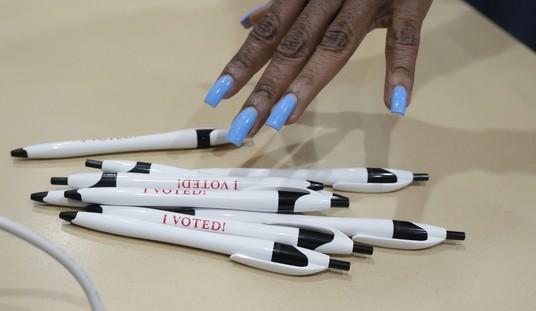What a great week for the President last week! A jobs report that exceeded expectations (yet again!), the best SOTU address in memory (while the Democrats disrespected Americans by sitting on their hands), Speaker Pelosi’s disastrous political faux pas tearing up the speech (proving that she’s not the political genius that the media purport her to be), the Democrats’ debacle in Iowa (and they want to manage our healthcare?), and – oh, yeah! – an acquittal that lasts forever (how do you like them apples, San Fran Nan?).
The good news was reported by Paul Bedard in the Washington Examiner here.
Democratic pollster John Zogby even gave the president his first A+ and noted that Trump’s week was made better by the hapless Democrats. Meanwhile, several polls, notably Gallup, found Trump reaching his highest job approval yet.
In that article, Democrat pollster John Zogby graded the President’s week and reported the good news in his own words:
John Zogby
Grade A+Yes — you are looking at my actual weekly grade for President Trump. Not only did the president have a good week, but he benefited from the simply terrible week the Democrats had.
Trump modulated his tone for his State of the Union speech and gave a combination of red-meat goals for fellow conservatives and statesmanlike achievements for voters as a whole. At the same time, he actually pitched some policies aimed at capturing a few extra black voters — school choice, economic opportunity zones, and increased (lifesaving) funding for historically black colleges.
The legacy media of course can’t handle the good news for the President and did their damnedest to suppress it over the weekend, as colleague Streiff reported here. Fortunately, Fox News isn’t completely captured by the Left, and occasionally a ray of light breaks through the gloom and doom purveyed by all the Democrat hacks that keep appearing throughout the day. One such bright light was Larry Kudlow’s interview with Bill Hemmer. Kudlow is former supply-side Wall Street economist and is the President’s Director of the National Economic Council. Here are excerpts from the Q&A:
Hemmer: I know you’ve got a lot of good news; good ahead and give us what you believe are the headlines…
Kudlow: Well, it’s a blowout number – 225,000 [new jobs in January] – it beat expectations. By the way, the household survey, from which unemployment is derived, that thing was up over 400,000, and the unemployment rate 3.6% … take that a little bit for good reasons. Lots and lots of people are reentering the labor force. You know about 3.5 million people have reentered the labor force under President Trump’s tenure, and they’re still going strong, and our calculations on the employment population ration suggests there’s another 6 million people that could enter the labor force. There’s no inflation, and I just gotta say it at the top the middle class boom – the blue collar boom – continued.
Hemmer: That was the message from earlier in the week. It’s evident that companies need employees, and you want good talent, too. What is the White House policy to ensure that the work force grows in that way? Like these tech companies that are looking for sophisticated workers. What are you going to do about that?
Kudlow: We’ve had a tremendous campaign led by my colleague and friend Ivanka Trump for training, retraining, re-skilling, as she calls it. I mean, she’s been in touch with over 400 corporations covering roughly 15 million workers, and everybody … we’re doing this through the private sector because these government training programs have proven not to work. So we’re covering a wide swath through the American economy, and you can convert people and retrain them and re-skill them, and that’s exactly what we’re doing. And it’s a crucial part because one reason one reason why people are coming out of the woodwork back into the labor force is first of all, wagers are up. Average weekly earnings for productions workers … 5.2% year on year … that’s a huge number. Their friends are working, their brothers-in-law are working, their sister-in-law is working …. And they know – because this is advertising word-of-mouth – they know that they can come and be trained to come and do the new work in the technology economy. So this is the huge part of it.
Hemmer: So here we go on the numbers. President Trump says he inherited a mess. Speaker Pelosi says he came in with head winds that weren’t as bad as he said. 6.07 million jobs in Trumps’ first three years versus 8.07 million jobs in Obama’s last three years. Is that a mess, or was the curve in your favor?
Kudlow: Well, look … the last two years of the prior administration were very soft years, but we actually created 7 million with the revisions – 7 million jobs in three years, and again, the prior administration had an outflow of workers leaving the labor force. We had an inflow of 3.5 million, and the wage changes are really crucial. Look, I know the other side of the aisle tries to paint a picture … the economy is in a recession, the middle class is getting killed, and only seven fat cats on Wall Street are making money. That is the biggest cognitive dissonance I’ve ever heard because what the facts show is, the winners in the last three years are the blue collar workers and the lower rungs of the wages, which are rising much faster than the top rungs, and even on things like the stock market … and the increase in household wealth is mostly the …..
Hemmer: Manufacturing jobs in the past 3 years have been up 482,000 versus only 288,000 in the last three years of the Obama administration. I know you want that number to be higher, and today there was a suggestion that it was a little stronger but there was some softening in the manufacturing sector. You have said that GDP growth: Trump’s 3-year average is 2.5% versus the last three years of Obama at 2.3%. Now you and others have said that you can blow by 3%; it hasn’t happened. How come?
Kudlow: Well, we had it going in 2017 up to the middle of 2018. We had it going at 3, 3.5 to 4. But then we got smashed by some very tight money by our friends at our local central bank, the Federal Reserve. That’s correct; that did not help a lot, and I believe that was unnecessary because there hasn’t been a whiff of inflation. Now, overseas growth has been nil; that hasn’t helped as much as we would like. And I will acknowledge this. The President has negotiated two huge trade deals, one with China and one with North America – USMCA. We’ve also got something out of Japan and Korea. I acknowledge that there was some negotiating uncertainty that may have slowed down Cap-X which is where the weakness has come, but last night, President Xi and President Trump had a very good phone call. President Xi reaffirmed Chinese purchases of US exports … a couple of hundred billion … It might take another few months because of the virus, but they reaffirmed that … they slashed tariffs. My point is this. The uncertainty barrier – the uncertainty factor – is coming down, and I think that could give us extra strength on the GDP.
Hemmer: Is the coronavirus the kind of thing that can suggest the end to this cycle. Do you see that as a possibility? Is there something else out there on the horizon that could bring the bears back?
Kudlow: Well, look. The coronavirus is essentially a China problem, and we’re doing everything we can to help them, by the way. Offering them advice, sending smart people over there, and so forth. It’s not a US problem. The impact on the American economy will be very, very, very small, if any. Actually, you’ve had two months of virus – December, January. The January numbers have come in great not just in manufacturing but in services, low unemployment, and housing. We really haven’t seen any economic impact. There may be some out there. Our own internal numbers say maybe two-tenths of a percent in the first quarter, but that’s not going to end this growth cycle. If anything – and give President Trump some credit, please – his strong SOTU message, his confidence, his optimism, and tax cuts and deregulation and good energy and trade deals – he has reinvigorated and restructure and rebuilt this economy. It’s almost like we’re starting a new recovery cycle, and that’s why this is going to go on for several years.
Hemmer: Would you predict a new trade deal with the UK or the EU before the election this year?
Kudlow: Very hard to predict. We’re looking at it. Good improvement on the EU. They have a new president, new trade negotiator … very good meetings with Bob Lighthizer yesterday. I spoke to Mr. Hogan [Phil Hogan, EU’s trade negotiator] afterwards … lots of intensity, lots of enthusiasm … and we’d like to have a new agreement with our cousins in the UK. Does it get done this year? I don’t know; it might, as the President would love to see it. More trade means more exports; more exports mean more high-paying jobs.
End of interview. The US economy keeps rolling along, and the impact of the two recently-signed trade deals will provide additional momentum. Manufacturing job growth doubled Obama’s numbers. Jobs hemorrhaged under Obama, and his employment numbers included part-time workers, as you will recall. The internal calculations of the National Economic Council indicated that the coronavirus impact on US GDP will be minimal. And there are future trade deals with the UK and EU in the works that will further stimulate the US economy for years to come. This is the American economy in the Age of Trump!
The end.













Join the conversation as a VIP Member